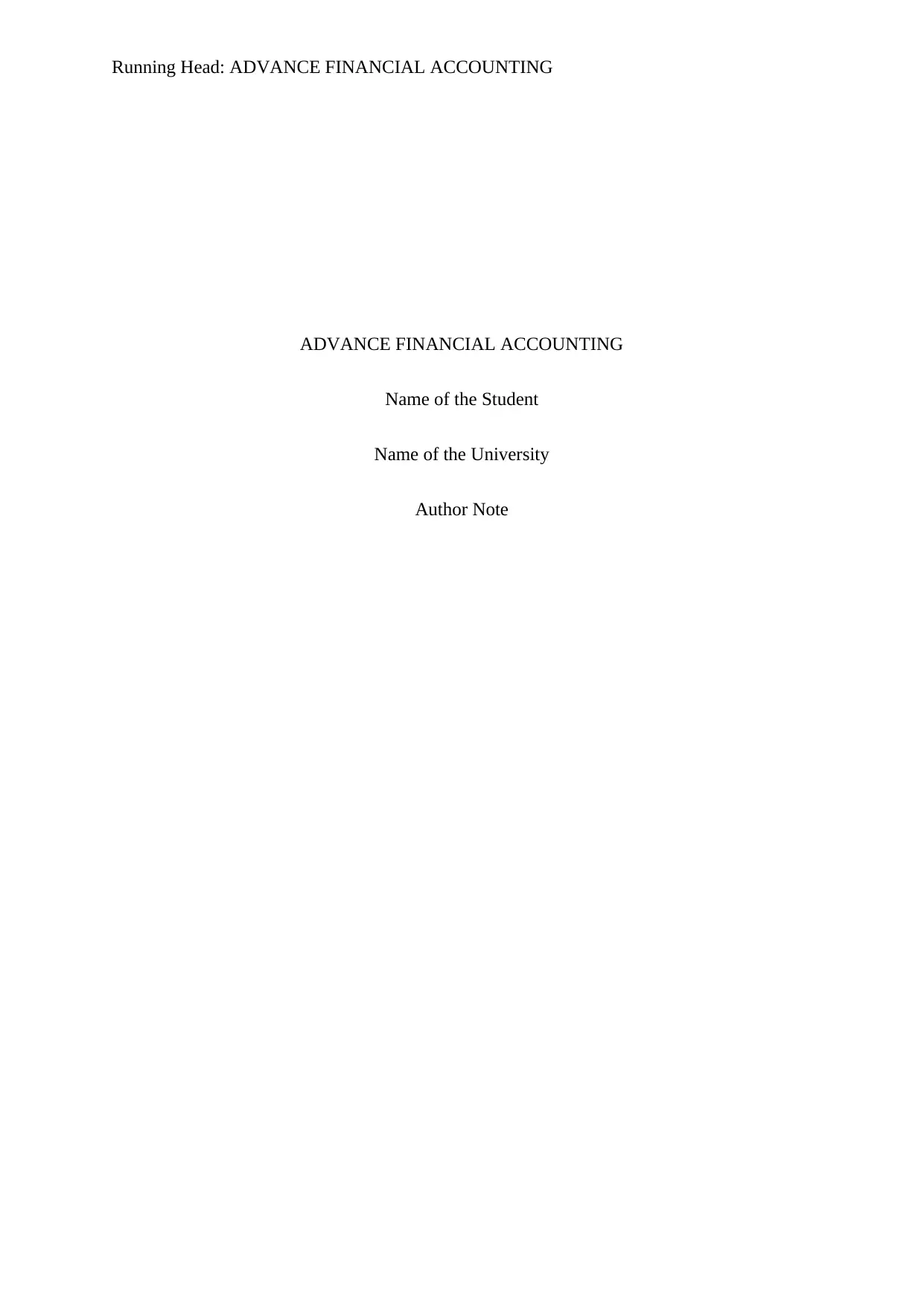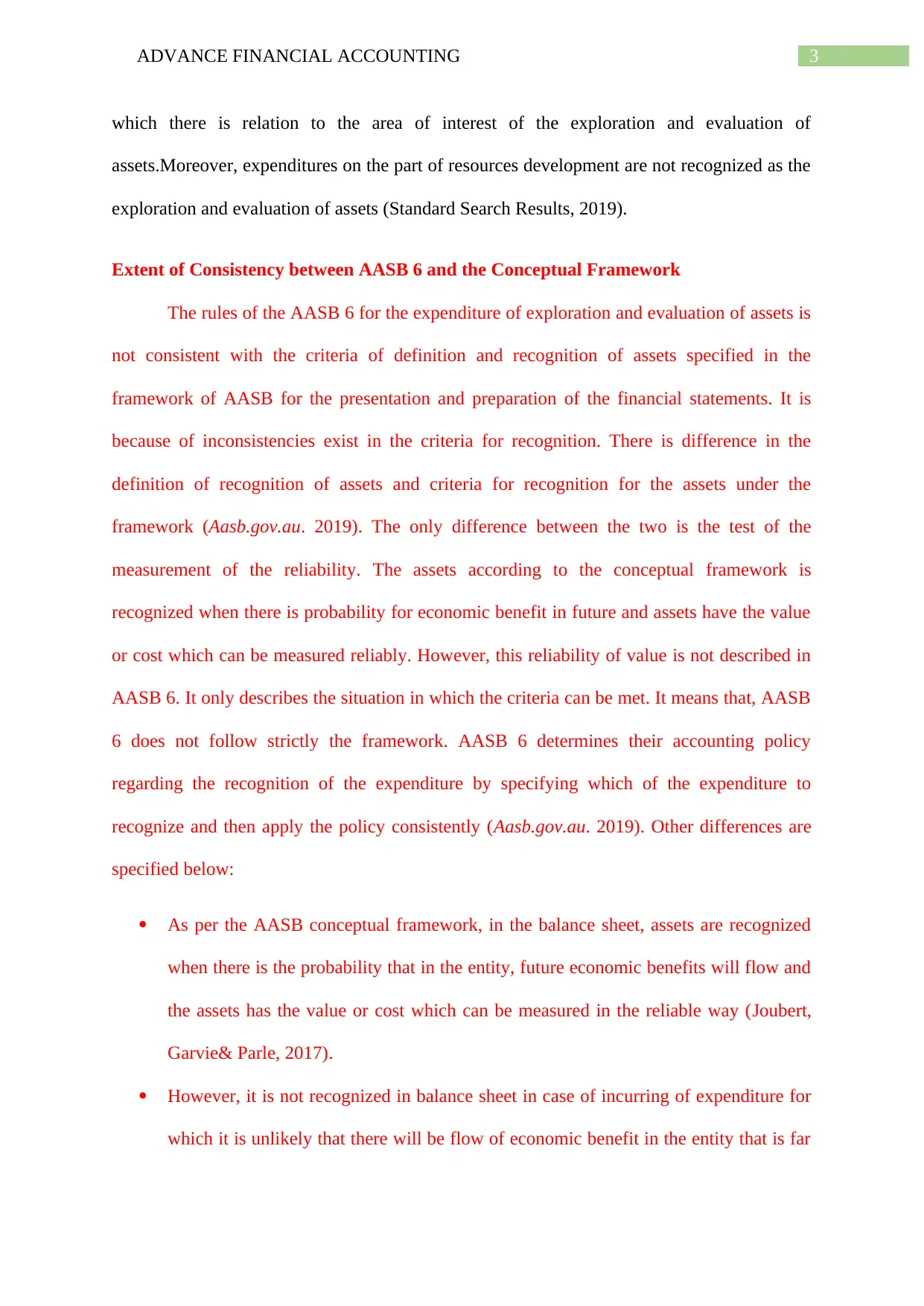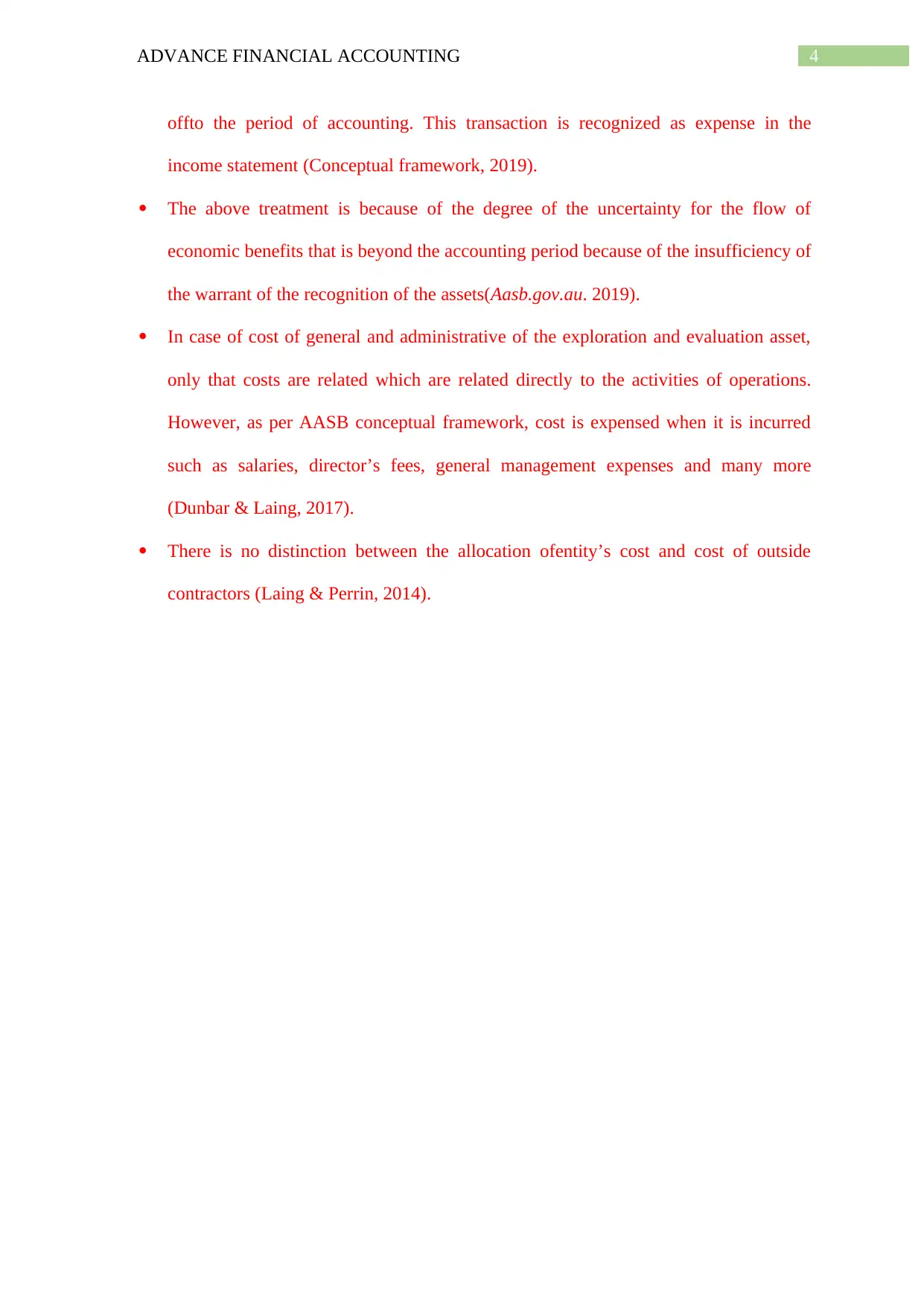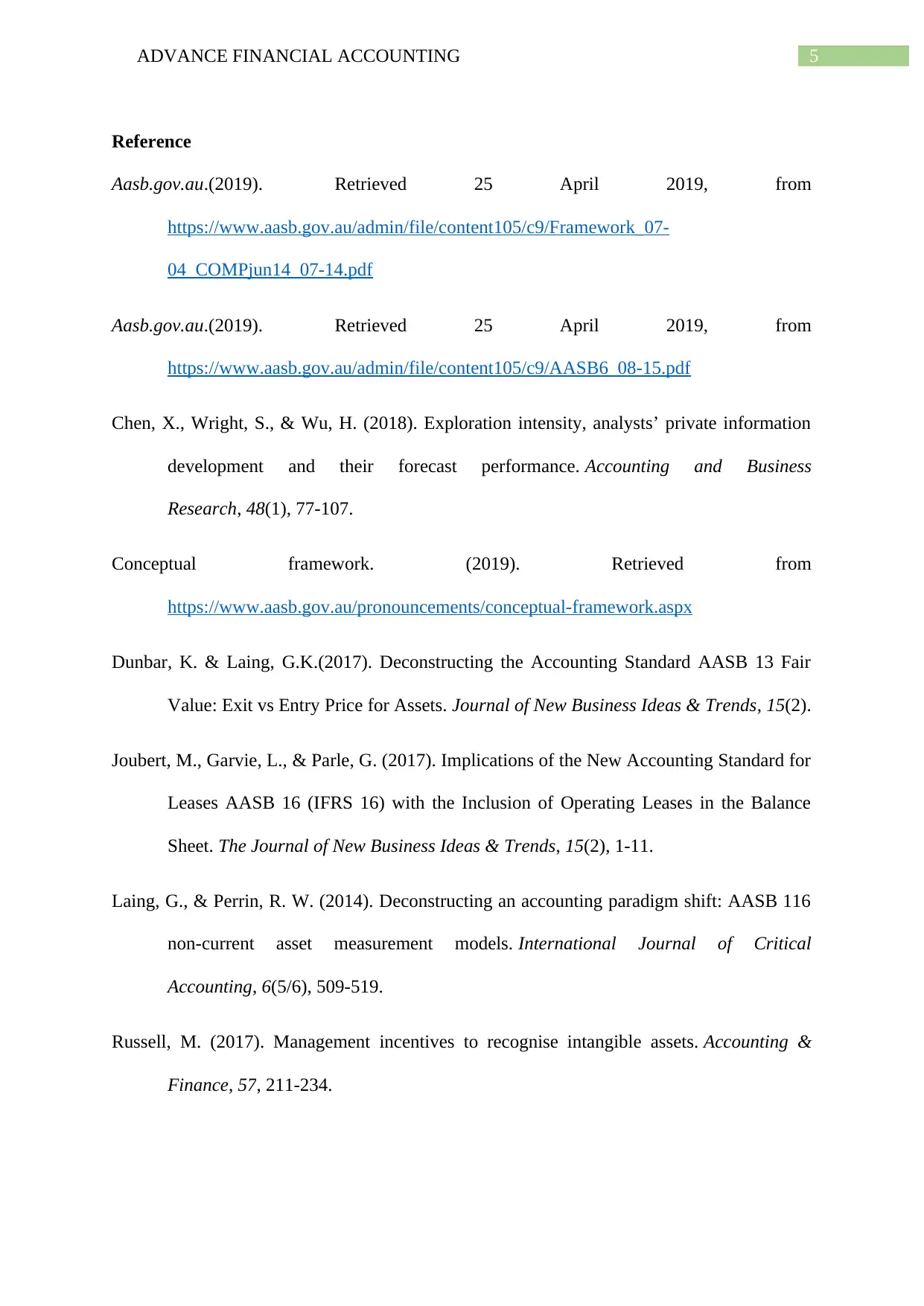Analysis of AASB 6 and the Conceptual Framework in Accounting
VerifiedAdded on 2023/02/01
|7
|1191
|51
Report
AI Summary
This report delves into the specifics of AASB 6, focusing on its implications for asset recognition, particularly in the context of exploration and evaluation expenditures. It outlines the criteria for recognizing assets, including the types of expenditures considered, such as exploration rights acquisition, exploratory drilling, and various geological studies. The report then assesses the consistency of AASB 6 with the Conceptual Framework, highlighting key differences in asset recognition criteria, particularly concerning the probability of future economic benefits and the reliable measurement of value. It contrasts the treatment of expenditures, such as general and administrative costs, and emphasizes the inconsistencies in applying the Conceptual Framework's asset recognition principles. The report also examines the implications of these differences and their impact on financial reporting.

Running Head: ADVANCE FINANCIAL ACCOUNTING
ADVANCE FINANCIAL ACCOUNTING
Name of the Student
Name of the University
Author Note
ADVANCE FINANCIAL ACCOUNTING
Name of the Student
Name of the University
Author Note
Paraphrase This Document
Need a fresh take? Get an instant paraphrase of this document with our AI Paraphraser

1ADVANCE FINANCIAL ACCOUNTING
Table of Contents
AASB 6 and the Conceptual Framework...................................................................................2
Extent of Consistency between AASB 6 and the Conceptual Framework................................3
Reference....................................................................................................................................5
Table of Contents
AASB 6 and the Conceptual Framework...................................................................................2
Extent of Consistency between AASB 6 and the Conceptual Framework................................3
Reference....................................................................................................................................5

2ADVANCE FINANCIAL ACCOUNTING
AASB 6 and the Conceptual Framework
The determination of the accounting policy by the entity by specifying which of the
expenditure areidentifiedas asset’s evaluation and exploration and applies the policies
continuously. Hence, for determining this, there is considerations by the entity for the degree
to which, there is association of expenditure with the resources (Russell, 2017). The instances
of the expenditures,which are included in the asset’s exploration and evaluation, are as
follows:
Acquisitions of the rights for exploring.
Exploratory drilling
Sampling
Trenching
Geophysical, geochemical, topographical and geological studies
Activities that are in relation with the evaluation of feasibility, technical as well as
commercial viability of the extraction of the resources (Aasb.gov.au.2019).
When the entity recognizes the assets for exploration and evaluation then the direct and
indirect cost of it is allocated to specific area of interest associated with it. For allocation of
these costs, there is no distinction that is made in the cost that is incurred in the organization
and cost of the services that is performed by the consultant that is on behalf of the company
(Chen, Wright & Wu, 2018). If the leases and rights of tenure is obtained as a part of the
exploration and evaluation of the resources then their cost are included in the cost of asset’s
exploration and evaluation. Indirect cost is included in the cost for the exploration and
evaluation of assets such as depreciation of equipment (Zhou, Birt& Rankin, 2015). In
addition, general and administrative cost are included in asset’s exploration and evaluation,
however, to the extent that, the costs are related directly to the activities of the operations in
AASB 6 and the Conceptual Framework
The determination of the accounting policy by the entity by specifying which of the
expenditure areidentifiedas asset’s evaluation and exploration and applies the policies
continuously. Hence, for determining this, there is considerations by the entity for the degree
to which, there is association of expenditure with the resources (Russell, 2017). The instances
of the expenditures,which are included in the asset’s exploration and evaluation, are as
follows:
Acquisitions of the rights for exploring.
Exploratory drilling
Sampling
Trenching
Geophysical, geochemical, topographical and geological studies
Activities that are in relation with the evaluation of feasibility, technical as well as
commercial viability of the extraction of the resources (Aasb.gov.au.2019).
When the entity recognizes the assets for exploration and evaluation then the direct and
indirect cost of it is allocated to specific area of interest associated with it. For allocation of
these costs, there is no distinction that is made in the cost that is incurred in the organization
and cost of the services that is performed by the consultant that is on behalf of the company
(Chen, Wright & Wu, 2018). If the leases and rights of tenure is obtained as a part of the
exploration and evaluation of the resources then their cost are included in the cost of asset’s
exploration and evaluation. Indirect cost is included in the cost for the exploration and
evaluation of assets such as depreciation of equipment (Zhou, Birt& Rankin, 2015). In
addition, general and administrative cost are included in asset’s exploration and evaluation,
however, to the extent that, the costs are related directly to the activities of the operations in
⊘ This is a preview!⊘
Do you want full access?
Subscribe today to unlock all pages.

Trusted by 1+ million students worldwide

3ADVANCE FINANCIAL ACCOUNTING
which there is relation to the area of interest of the exploration and evaluation of
assets.Moreover, expenditures on the part of resources development are not recognized as the
exploration and evaluation of assets (Standard Search Results, 2019).
Extent of Consistency between AASB 6 and the Conceptual Framework
The rules of the AASB 6 for the expenditure of exploration and evaluation of assets is
not consistent with the criteria of definition and recognition of assets specified in the
framework of AASB for the presentation and preparation of the financial statements. It is
because of inconsistencies exist in the criteria for recognition. There is difference in the
definition of recognition of assets and criteria for recognition for the assets under the
framework (Aasb.gov.au. 2019). The only difference between the two is the test of the
measurement of the reliability. The assets according to the conceptual framework is
recognized when there is probability for economic benefit in future and assets have the value
or cost which can be measured reliably. However, this reliability of value is not described in
AASB 6. It only describes the situation in which the criteria can be met. It means that, AASB
6 does not follow strictly the framework. AASB 6 determines their accounting policy
regarding the recognition of the expenditure by specifying which of the expenditure to
recognize and then apply the policy consistently (Aasb.gov.au. 2019). Other differences are
specified below:
As per the AASB conceptual framework, in the balance sheet, assets are recognized
when there is the probability that in the entity, future economic benefits will flow and
the assets has the value or cost which can be measured in the reliable way (Joubert,
Garvie& Parle, 2017).
However, it is not recognized in balance sheet in case of incurring of expenditure for
which it is unlikely that there will be flow of economic benefit in the entity that is far
which there is relation to the area of interest of the exploration and evaluation of
assets.Moreover, expenditures on the part of resources development are not recognized as the
exploration and evaluation of assets (Standard Search Results, 2019).
Extent of Consistency between AASB 6 and the Conceptual Framework
The rules of the AASB 6 for the expenditure of exploration and evaluation of assets is
not consistent with the criteria of definition and recognition of assets specified in the
framework of AASB for the presentation and preparation of the financial statements. It is
because of inconsistencies exist in the criteria for recognition. There is difference in the
definition of recognition of assets and criteria for recognition for the assets under the
framework (Aasb.gov.au. 2019). The only difference between the two is the test of the
measurement of the reliability. The assets according to the conceptual framework is
recognized when there is probability for economic benefit in future and assets have the value
or cost which can be measured reliably. However, this reliability of value is not described in
AASB 6. It only describes the situation in which the criteria can be met. It means that, AASB
6 does not follow strictly the framework. AASB 6 determines their accounting policy
regarding the recognition of the expenditure by specifying which of the expenditure to
recognize and then apply the policy consistently (Aasb.gov.au. 2019). Other differences are
specified below:
As per the AASB conceptual framework, in the balance sheet, assets are recognized
when there is the probability that in the entity, future economic benefits will flow and
the assets has the value or cost which can be measured in the reliable way (Joubert,
Garvie& Parle, 2017).
However, it is not recognized in balance sheet in case of incurring of expenditure for
which it is unlikely that there will be flow of economic benefit in the entity that is far
Paraphrase This Document
Need a fresh take? Get an instant paraphrase of this document with our AI Paraphraser

4ADVANCE FINANCIAL ACCOUNTING
offto the period of accounting. This transaction is recognized as expense in the
income statement (Conceptual framework, 2019).
The above treatment is because of the degree of the uncertainty for the flow of
economic benefits that is beyond the accounting period because of the insufficiency of
the warrant of the recognition of the assets(Aasb.gov.au. 2019).
In case of cost of general and administrative of the exploration and evaluation asset,
only that costs are related which are related directly to the activities of operations.
However, as per AASB conceptual framework, cost is expensed when it is incurred
such as salaries, director’s fees, general management expenses and many more
(Dunbar & Laing, 2017).
There is no distinction between the allocation ofentity’s cost and cost of outside
contractors (Laing & Perrin, 2014).
offto the period of accounting. This transaction is recognized as expense in the
income statement (Conceptual framework, 2019).
The above treatment is because of the degree of the uncertainty for the flow of
economic benefits that is beyond the accounting period because of the insufficiency of
the warrant of the recognition of the assets(Aasb.gov.au. 2019).
In case of cost of general and administrative of the exploration and evaluation asset,
only that costs are related which are related directly to the activities of operations.
However, as per AASB conceptual framework, cost is expensed when it is incurred
such as salaries, director’s fees, general management expenses and many more
(Dunbar & Laing, 2017).
There is no distinction between the allocation ofentity’s cost and cost of outside
contractors (Laing & Perrin, 2014).

5ADVANCE FINANCIAL ACCOUNTING
Reference
Aasb.gov.au.(2019). Retrieved 25 April 2019, from
https://www.aasb.gov.au/admin/file/content105/c9/Framework_07-
04_COMPjun14_07-14.pdf
Aasb.gov.au.(2019). Retrieved 25 April 2019, from
https://www.aasb.gov.au/admin/file/content105/c9/AASB6_08-15.pdf
Chen, X., Wright, S., & Wu, H. (2018). Exploration intensity, analysts’ private information
development and their forecast performance. Accounting and Business
Research, 48(1), 77-107.
Conceptual framework. (2019). Retrieved from
https://www.aasb.gov.au/pronouncements/conceptual-framework.aspx
Dunbar, K. & Laing, G.K.(2017). Deconstructing the Accounting Standard AASB 13 Fair
Value: Exit vs Entry Price for Assets. Journal of New Business Ideas & Trends, 15(2).
Joubert, M., Garvie, L., & Parle, G. (2017). Implications of the New Accounting Standard for
Leases AASB 16 (IFRS 16) with the Inclusion of Operating Leases in the Balance
Sheet. The Journal of New Business Ideas & Trends, 15(2), 1-11.
Laing, G., & Perrin, R. W. (2014). Deconstructing an accounting paradigm shift: AASB 116
non-current asset measurement models. International Journal of Critical
Accounting, 6(5/6), 509-519.
Russell, M. (2017). Management incentives to recognise intangible assets. Accounting &
Finance, 57, 211-234.
Reference
Aasb.gov.au.(2019). Retrieved 25 April 2019, from
https://www.aasb.gov.au/admin/file/content105/c9/Framework_07-
04_COMPjun14_07-14.pdf
Aasb.gov.au.(2019). Retrieved 25 April 2019, from
https://www.aasb.gov.au/admin/file/content105/c9/AASB6_08-15.pdf
Chen, X., Wright, S., & Wu, H. (2018). Exploration intensity, analysts’ private information
development and their forecast performance. Accounting and Business
Research, 48(1), 77-107.
Conceptual framework. (2019). Retrieved from
https://www.aasb.gov.au/pronouncements/conceptual-framework.aspx
Dunbar, K. & Laing, G.K.(2017). Deconstructing the Accounting Standard AASB 13 Fair
Value: Exit vs Entry Price for Assets. Journal of New Business Ideas & Trends, 15(2).
Joubert, M., Garvie, L., & Parle, G. (2017). Implications of the New Accounting Standard for
Leases AASB 16 (IFRS 16) with the Inclusion of Operating Leases in the Balance
Sheet. The Journal of New Business Ideas & Trends, 15(2), 1-11.
Laing, G., & Perrin, R. W. (2014). Deconstructing an accounting paradigm shift: AASB 116
non-current asset measurement models. International Journal of Critical
Accounting, 6(5/6), 509-519.
Russell, M. (2017). Management incentives to recognise intangible assets. Accounting &
Finance, 57, 211-234.
⊘ This is a preview!⊘
Do you want full access?
Subscribe today to unlock all pages.

Trusted by 1+ million students worldwide

6ADVANCE FINANCIAL ACCOUNTING
Standard Search Results. (2019). Retrieved from
https://www.aasb.gov.au/Pronouncements/Standard-Results.aspx?
standard_search=AASB%206
Zhou, T., Birt, J., & Rankin, M. (2015). The value relevance of exploration and evaluation
expenditures. Accounting Research Journal, 28(3), 228-250.
Standard Search Results. (2019). Retrieved from
https://www.aasb.gov.au/Pronouncements/Standard-Results.aspx?
standard_search=AASB%206
Zhou, T., Birt, J., & Rankin, M. (2015). The value relevance of exploration and evaluation
expenditures. Accounting Research Journal, 28(3), 228-250.
1 out of 7
Related Documents
Your All-in-One AI-Powered Toolkit for Academic Success.
+13062052269
info@desklib.com
Available 24*7 on WhatsApp / Email
![[object Object]](/_next/static/media/star-bottom.7253800d.svg)
Unlock your academic potential
Copyright © 2020–2025 A2Z Services. All Rights Reserved. Developed and managed by ZUCOL.





